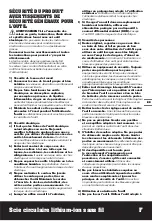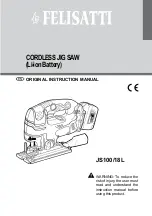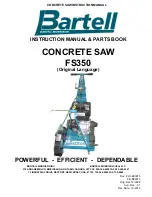
Lithium-Ion cordless circular saw EN
8
operating procedures or conditions and can be
avoided by taking proper precautions as given below.
a) Maintain a firm grip with both hands on
the saw and position your arms to resist
kickback forces. Position your body to
either side of the blade, but not in line with
the blade.
Kickback could cause the saw to jump
backwards, but kickback forces can be controlled
by the operator, if proper precautions are taken.
b) When blade is binding, or when interrupting
a cut for any reason, release the trigger and
hold the saw motionless in the material until
the blade comes to a complete stop. Never
attempt to remove the saw from the work
or pull the saw backward while the blade is
in motion or kickback may occur.
Investigate
and take corrective actions to eliminate the cause
of blade binding.
c) When restarting a saw in the workpiece,
centre the saw blade in the kerf so that the
saw teeth are not engaged into the material.
If a saw blade binds, it may walk up or kickback
from the workpiece as the saw is restarted.
d) Support large panels to minimise the risk
of blade pinching and kickback.
Large panels
tend to sag under their own weight. Supports
must be placed under the panel on both sides,
near the line of cut and near the edge of the
panel.
e) Do not use dull or damaged blades.
Unsharpened or improperly set blades produce
narrow kerf causing excessive friction, blade
binding and kickback.
f) Blade depth and bevel adjusting locking
levers must be tight and secure before
making the cut.
If blade adjustment shifts while
cutting, it may cause binding and kickback.
g) Use extra caution when sawing into existing
walls or other blind areas.
The protruding
blade may cut objects that can cause kickback.
SAFETY INSTRUCTIONS
FOR CIRCULAR SAW WITH
INNER PENDULUM GUARD
Lower guard function
a) Check the lower guard for proper closing
before each use. Do not operate the saw if
the lower guard does not move freely and
close instantly. Never clamp or tie the lower
guard into the open position.
If the saw is
accidentally dropped, the lower guard may be
bent. Raise the lower guard with the retracting
handle and make sure it moves freely and does
not touch the blade or any other part, in all angles
and depths of cut.
b) Check the operation of the lower guard
spring. If the guard and the spring are not
operating properly, they must be serviced
before use.
Lower guard may operate sluggishly
due to damaged parts, gummy deposits, or a
build-up of debris.
c) The lower guard may be retracted manually
only for special cuts such as "plunge cuts"
and "compound cuts." Raise the lower
guard by retracting handle and as soon as
the blade enters the material, the lower
guard must be released.
For all other sawing,
the lower guard should operate automatically.
d) Always observe that the lower guard is
covering the blade before placing the saw
down on bench or floor.
An unprotected,
coasting blade will cause the saw to walk
backwards, cutting whatever is in its path. Be
aware of the time it takes for the blade to stop
after switch is released.
ADDITIONAL SAFETY
RULES FOR YOUR CIRCULAR
SAW
1. Use only saw blades recommended by the
manufacturer, which conform to EN 847-1, if
intended for wood and analogous materials.
2. Do not use any abrasive wheels.
3. Use only blade diameter(s) in accordance with the
markings.
4. Identify the correct saw blade to be used for the
material to be cut.
5. Use only saw blades that are marked with a speed
equal or higher than the speed marked on the
tool.
SAFETY WARNINGS FOR
BATTERY PACK
a) Do not dismantle, open or shred cells or
battery pack.
b) Do not short-circuit a battery pack. Do not
store battery packs haphazardly in a box or
drawer where they may short-circuit each
other or be short-circuited by conductive
materials.
When battery pack is not in use,
keep it away from other metal objects, like paper
clips, coins, keys, nails, screws or other small
metal objects, that can make a connection from
one terminal to another. Shorting the battery
terminals together may cause burns or a fire.
c) Do not expose battery pack to heat or fire.
Avoid storage in direct sunlight.
d) Do not subject battery pack to mechanical
shock.
e) In the event of battery leaking, do not
allow the liquid to come into contact
with the skin or eyes. If contact has been
made, wash the affected area with copious
amounts of water and seek medical advice.
f) Seek medical advice immediately if a cell or
battery pack has been swallowed.
g) Keep battery pack clean and dry.









































